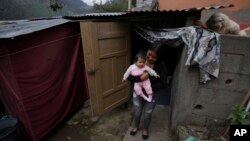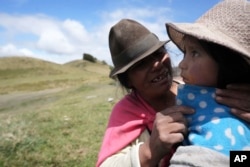Erwin Ronquillo, an official with the government program Ecuador Grows Without Malnutrition, is worried about hunger in his country.
Ronquillo said child malnutrition is chronic among Ecuador’s population. It is seen everywhere, but hits hardest in rural areas and among the country’s Native peoples, he said.
The United Nations children’s agency UNICEF keeps information related to children and their development for countries around the world. UNICEF information suggests that one in three Ecuadorian children suffers from malnutrition. Of those, about 41 percent are Native.
Neiri Espinosa is a mother whose partner left her. She lives in a neighborhood of the capital city, Quito, called Pisulí. She said her children, who are eight and four years old, do not usually eat meat. Both children appear to be younger because of their height and the thinness of the youngest girl.
Sometimes the family buys chicken, but not often, Espinosa said.
“It is difficult to get any job (as a domestic worker), worse after the pandemic,” she said.
Monica Cabrera is with the Ministry of Economic and Social Inclusion. She works in the Camal Metropolitano neighborhood on the southern edge of Quito. It is a high-risk area. Cabrera has been robbed several times there.
She visits the homes of at least 25 young mothers. Two of the mothers are minors: 15 and 17 years old. Her job is to support the group of mothers while they are pregnant until their children reach one year of age.
Cabrera said the poorest people in the city are usually Native migrants from rural areas. They try to earn a living by selling waste materials, making building materials, or selling products on the streets.
“Those who have more have the luxury of eating twice a day,” Cabrera said. She said she knows of families that eat only once a day and sometimes not even that.
UNICEF’s numbers suggest that 50 percent of Ecuadorian households with children had difficulty getting the necessary food in 2021 because of the pandemic. As a result, 27 percent of children had their development affected because of chronic malnutrition, the agency said.
In addition, 72 percent of children lacked basic services for development, such as health and education, UNICEF said.
Ecuador’s government is led by President Guillermo Lasso, a former banker. The government has pledged to fight chronic malnutrition. It has promised to spend $350 million a year to improve health, family, education, and support services.
Tania Herrara lives with her parents and has a baby, Sara Milena. Herrara receives a $50 monthly stipend from the government to support the baby. To receive that money, she promised to join all child support activities that she is asked to attend.
Her parents currently support the family. They earn between $5 and $7 a day. That amount must feed five adults. It also must serve to support the new arrival. The adults hope to eat something twice a day.
The family has lived in Quito for several years. They can only pay for chicken meat from time to time. The baby is breastfed.
I’m Caty Weaver.
Gonzalo Solano reported this story for The Associated Press. Gregory Stachel adapted it for VOA Learning English.
_____________________________________________________________
Words in This Story
malnutrition – n. the unhealthy condition that results from not eating enough food or not eating enough healthy food
chronic – adj. continuing or occurring again and again for a long time
domestic – adj. relating to the work (such as cooking and cleaning) that is done in a person's home
luxury – n. something that is helpful or welcome and that is not usually or always available
pledge – v. to formally promise to give or do (something)
stipend – n. a usually small amount of money that is paid regularly to someone
____________________________________________________________
What do you think of this story?
We want to hear from you. We have a new comment system. Here is how it works:
- Write your comment in the box.
- Under the box, you can see four images for social media accounts. They are for Disqus, Facebook, Twitter and Google.
- Click on one image and a box appears. Enter the login for your social media account. Or you may create one on the Disqus system. It is the blue circle with “D” on it. It is free.
Each time you return to comment on the Learning English site, you can use your account and see your comments and replies to them. Our comment policy is here.











Forum